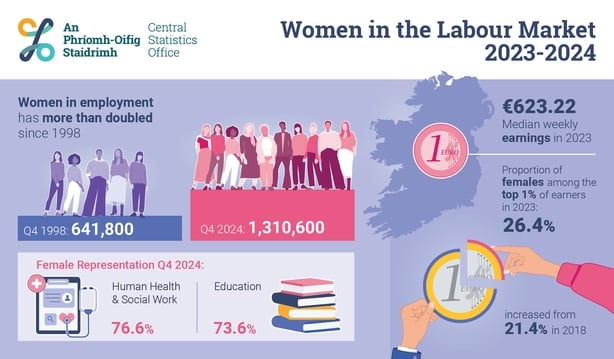New figures from the Central Statistics Office show the number of women in employment has more than doubled since 1998 to 1,310,600 in the fourth quarter of 2024, a 104.2% increase from the 641,800 reported in the fourth quarter of 1998.
Today’s CSO figures also show that women who reported their “principal economic status” as “engaged in home duties” decreased by 60% from 520,500 in 2010 to 208,200 in 2024.
Meanwhile, women accounted for 41.9% of people in full-time employment, and 67.3% of people in part-time employment in the final quarter of 2024.
In its Women in the Labour Market report, the CSO noted that the number of married women in employment rose by 21.5% over the five years from the final quarter of 2019 to the final quarter of last year.
On pay, the CSO said that median weekly earnings for women rose by 32.7% between 2013’s figure of €469.74 and 2023’s figure of €623.22. This compares with an increase of 30.5% in median weekly earnings for men over the same time, from €590.63 in 2013 to €770.52 in 2023.
In the past five years, the proportion of women among the top 1% of earners increased from 21.4% in 2018 to 26.4% in 2023, while the proportion of women with earnings in the top 10% rose from 27.8% to 30.2% over the same time.
The CSO also note that the Gender Pay Gap (GPG) in 2022 – which measures the average difference between men and women’s hourly earnings – was 9.6%, with mean hourly earnings for men at €27.73 and €25.06 for women.
Today’s figures also reveal that 62.6% of women in employment have a third level degree compared with 50.7% of men.
The Human Health & Social Work sector had the highest number of female employees, followed by the Education sector, with women representing around three-quarters of employees in both sectors, the CSO noted.

The CSO also noted that the Gender Pay Gap (GPG) in 2022 – which measures the average difference between men and women’s hourly earnings – was 9.6%, with mean hourly earnings for men at €27.73 and €25.06 for women.
Today’s figures also reveal that 62.6% of women in employment have a third level degree compared with 50.7% of men.
The Human Health & Social Work sector had the highest number of female employees, followed by the Education sector, with women representing around three-quarters of employees in both sectors, the CSO noted.



